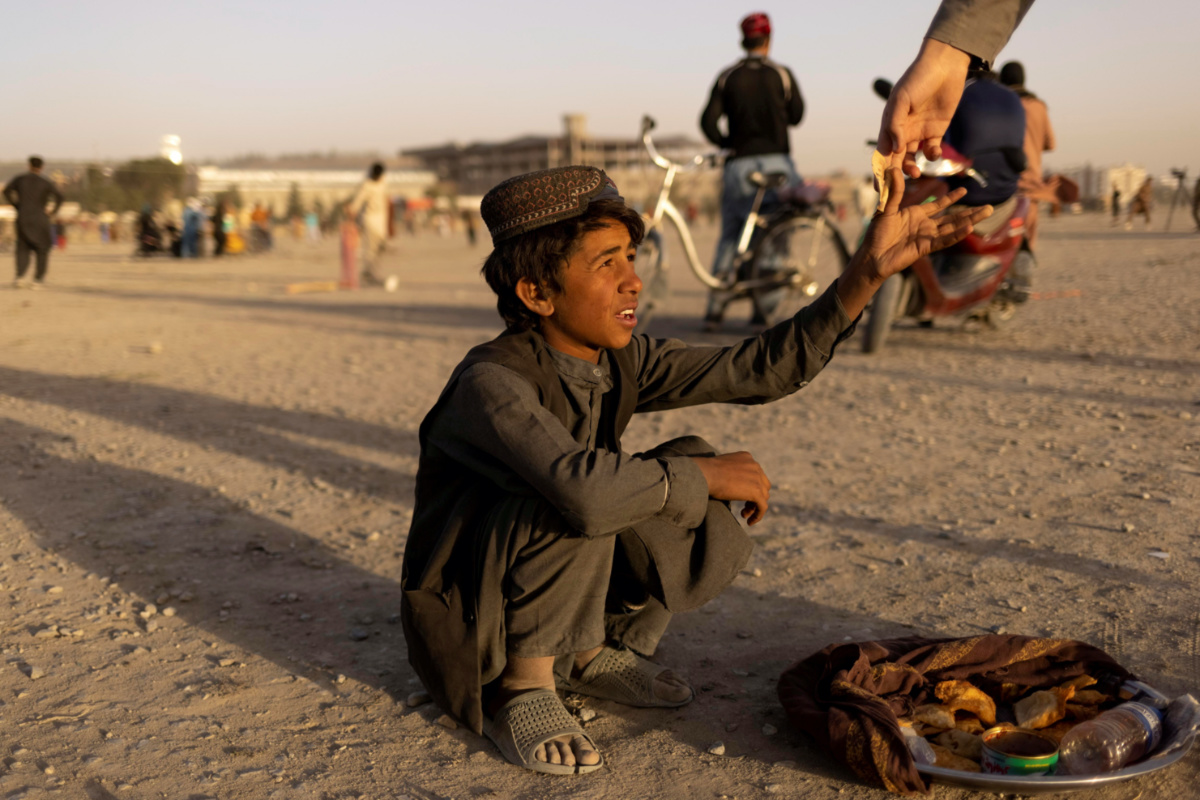Bogota, Colombia
Thomson Reuters Foundation
One in 29 people worldwide needs humanitarian assistance, the United Nations said last week, as under-funded aid agencies struggle to keep pace with rising human suffering driven by the climate crisis, COVID-19 impacts and conflict.
The number of people in need continues to rise “at an alarming rate”, with a total of 274 million people expected to require humanitarian assistance next year – up 17 per cent from 2020.

A boy sells food in a park in Kabul, Afghanistan, on 22nd October. PICTURE: REUTERS/Jorge Silva/File photo.
Growing numbers of people are battling hunger and extreme poverty in part as a result of more extreme weather, such as Hurricanes Eta and Iota that hit Central America last year, and a drought in Afghanistan that is the worst in 27 years, UN officials said.
This year the “climate crisis reached boiling point,” said UN Secretary-General Antonio Guterres said on Thursday at the launch of an appeal for $US41 billion to provide life-saving assistance next year to a record 183 million people – those considered most at need.
But aid requirements continue to outpace funding, he said in a video address during an online event hosted by the Center for Strategic and International Studies, a Washington-based thinktank.
John J Hamre, CSIS president, said climate change impacts are “running rampant” around the world.
“The humanitarian response is not keeping up – it is failing to deal with these great challenges,” he said.
We rely on our readers to fund Sight's work - become a financial supporter today!
For more information, head to our Subscriber's page.
Women first
The US Agency for International Development (USAID) and non-profits called for women-led organisations in local communities to receive priority for funding.
Such groups are often the first responders to deal with extreme weather events.
Climate change can erode agricultural production, deepen poverty, and exacerbate the underlying political, social, and economic stresses that provoke and prolong conflict in fragile states, expert said.
In countries experiencing lengthy conflicts, such as Yemen, Afghanistan, and Syria, climate change is “looming over it all, exacerbating losses and undoing gains,” said USAID Administrator Samantha Power.
A shift in approach is needed to bring protracted conflicts to an end, using “relentless diplomacy,” she said.
Part of the shift involves working more closely with local communities, faith-based groups and women as humanitarian relief is delivered, and as climate adaptation plans are put in place.
Right now, “when it comes to designing how humanitarian need is distributed and who benefits from it, more often than not [women] don’t get a set at the table,” Power said.
UN aid chief Martin Griffiths said the growing climate crisis means “that no corner of the world is either immune from intensifying shocks…[or] the need for assistance.”
He noted that while collaboration has improved between international agencies and local responders on the frontlines in countries like Yemen, “we still forget them, we still don’t see them clearly”.
In Yemen, where a war pits a Saudi-led coalition against Iran-aligned Houthi forces, women and girls – who fetch water and can face violence while doing it – are particularly affected by hunger and drought exacerbated by climate change, said Antelak al-Mutawakel, co-founder of local non-profit The Youth Leadership Foundation.
“Tipping points”
Aid groups will need to adapt to key climate change tipping points that “may already have been reached or passed” as warming-related disasters become more frequent, UN officials said in their annual Global Humanitarian Overview report.
The report estimated up to 216 million people may have to move within their own countries by 2050 due to the effects of climate change.
In Central America, a region highly vulnerable to drought and massive floods cause by hurricanes, climate change has helped push hundreds of thousands of people to leave their homes in recent years, especially in rural areas.
“Forced migration is a phenomenon closely linked to climate, in addition to poverty and violence,” said Claudia Herrera, head of the Guatemala-based CEPREDENAC center for disaster prevention in Central America.
Men often migrate first, leaving women behind who then struggle to feed their families, she said.
“Women are the first to sacrifice nutrition and education,” said Herrera.
Natalia Kanem, head of the UN’s sexual and reproductive health agency, UNFPA, said the climate crisis produces a “gender chain reaction” that affects women more in terms of hunger and livelihoods lost.
“The people who are vulnerable cannot write a grant proposal,” said Kanem, urging more aid and technical assistance be channelled to local women-led groups.






